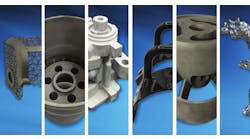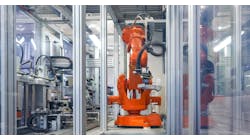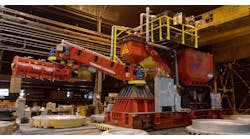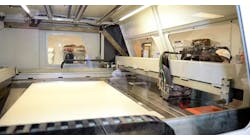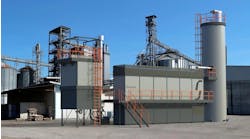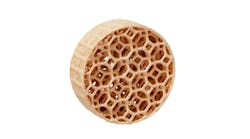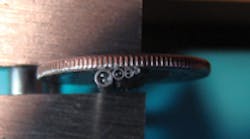Narrower wire dimensions are needed for thermocouple to achieve the faster response times, and for other practical reasons.
Thermocouple designers and manufacturers are really in the "time and temperature business." We need to achieve the most accurate temperature reading in the least amount of time. When rapid response is a mandate, the temperature change in the environment being monitored must reach the measuring junction rapidly. For this to happen, the temperature or steps in changing temperature must penetrate the sheath material and insulting material. Consequently, the smaller the diameter (less material to penetrate), the faster the response time.
Mineral-insulated cable as small as 0.010-inch in diameter is preferred for many applications for two reasons. The first reason is speed. When high temperatures are reached quickly, a conventional, less-responsive thermocouple could miss rapid temperature increases that must be measured. The second reason for small-diameter, mineral-insulated cable is high flexibility, for easy routing. In addition, higher-quality thermocouple materials are being used to control thermocouple drift. Today, many customers are looking for superior accuracy and stability. A recent industry trend is the replacement of the more traditional K calibration with N, which exhibits better stability characteristics at elevated temperatures.
High-temperature applications (2,000°F – 2,800°F) requiring calibrations R, S or B with the capability of a flexible sheath (ranging from 0.020 in. diameter) have long been satisfied using noble metals as the protection sheath material. Thermocouples of this configuration have historically been manufactured with the entire sheath comprised of platinum, or platinum alloyed with rhodium. Overall dimensions of these thermocouples are determined by the length necessary to reach from the hot zone (or portion of the furnace that will be monitored at the elevated temperature), out to a point where it transitions to extension wire that is connected to the control/recording device. The distance from the hot zone to that connection point can be 10 feet or more, making a platinum sheath thermocouple costly to fabricate. Now, with advanced manufacturing techniques, the cost of this assembly can be reduced by seamlessly transitioning the portion of the thermocouple not required to operate at the elevated temperature to a more cost efficient material such as stainless steel or Inconel.
Aerospace Material Specification (AMS 2750D) covers pyrometric requirements for thermal-processing equipment used for heat treatment. When impractical or impossible to perform a traditional System Accuracy Tests (SAT), a resident probe may be employed. SATs have specific requirements to qualify control thermocouples. Above 500°F, the resident SAT probe must be Type N, or S. Above 1,000°F, a non-expendable sheath must be used. Furthermore, a resident SAT thermocouple must be of a different calibration than the sensor being used to control the furnace.
These requirements have led to new designs. Dual-calibration MgO thermocouples are available that will incorporate the control thermocouple and the resident probe thermocouple in a common sheath. Dual calibrations such as K and N, J and N, and K and S, are some of the available combinations in sheath diameters as small as 1/8 inch.
The need for multi-sensor, staggered junction or combinations of both within a common sheath is rising. Applications calling for as many as 12 thermocouples can be configured in a common sheath as small as 0.125 in. OD, with or without staggered junctions.
Meeting Engine Test-Sensor Requirements — Turbine engine manufacturers that supply the truck, earthmover, power generation or aircraft markets work to increase horsepower, decrease emissions and reduce weight in their engines. Since the mid-‘90s, engines have become smaller, more fuel efficient, and more powerful.
Turbines can reach temperatures of up to 2,800°F in seconds. High temperatures and rapid increases have dictated advanced engine materials and sensors. For example, test engines with single-crystal vanes are smaller and hotter, and generate higher performance. Ceramic engine parts can exceed 2,800°F and require advanced thermocouples to monitor higher temperatures. New, faster, lighter and smaller thermocouples help provide the most accurate reading possible. Engine manufacturers test performance and emissions at very high temperatures. Precision temperature data is critical because a test engine that runs a few degrees too cool could fail to meet performance requirements.
Control systems for higher-technology engines require faster response times. Thermocouples must respond in fractions of a second versus seconds. Transient temperatures, melt points and indications of surge must be sensed immediately, so the faster the response time the more time the digital controls have to react and correct undesirable conditions and perhaps prevent catastrophic events.
Now, diagnostic rakes and probes must contain more sensors, but they are installed in smaller and smaller spaces. In the past, 20 sensors were considered a high number on a test engine. Today, 1,000 sensors can be insufficient. In the past, 0.040-inch diameter was considered the smallest. Now, even 0.010-inch diameter, while common, may be too large.
Test engines are carefully monitored for fuel consumption and performance. Every ounce of fuel consumed by an engine increases its operating costs. "Power by the hour" is the critical measure of engine performance. Engines that run hotter may be more efficient, but the trade-off may be lower engine life. Rotating engine components are measured for strain as well as temperature. They have higher creep and fatigue at high temperatures, but at higher RPM, more horsepower and thrust can be generated.
Fiber-optic technologies are raising the standards for sensing in many applications. Engine testing requires that many points on an engine be measured for temperature, vibration and strain. Fiber-optic sensors are now an alternative because they are corrosion-resistant, immune to EMI and RFI, and effective in hostile environments. Additionally, fiber-optic sensor systems can relay data hundreds of times faster than traditional sensors.
Routine engine tests may require hundreds of sensors. Traditional thermocouple sensors must be individually manufactured, tagged, and then installed into the data-acquisition system. It can take hundreds of hours to prepare for an engine test. Unlike traditional sensors, up to 80 fiber-optic sensors can be multiplexed on a single fiber and installed on a single-channel input. Traditional sensors would require 80 separate connections. Fiber-optic sensors reduce installation time and expense plus reduce weight and space requirements. Fiber-optic sensors are leading the way into sophisticated health monitoring systems that will be installed on all new aircraft designs in the near future.
Don Lieske is vice president of Quality and Don Way is engineering manager at the Cleveland Electric Laboratories Test Cell Instrumentation R&D Facility, Tempe, AZ.

